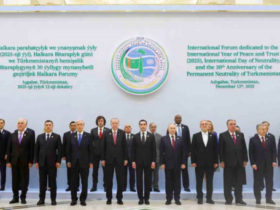By Sergio Rodríguez Gelfenstein
Last week I pointed out that the situation in Syria generated more questions than answers. About ten days after the terrorists took power, there are still no clear ideas about what is going to happen. Three powers occupy parts of Syria: The United States, Israel and Türkiye without the new government having made the slightest move to prevent that. Today the new regime is complicit in the partition of its country, the destruction of its sovereignty and the disappearance of the State.
Undoubtedly, in the tactical field, Israel, Türkiye and the United States are the winners in the face of the debacle of the al-Assad regime. However, it is necessary to provide some elements that allow us to offer guidelines to understand the consequences that this fact could have from a strategic perspective.
As stated, Iran lost an expensive logistical bridge that brought it closer to Lebanon and Palestine. Now, it will be necessary to know how much military, financial and logistical capacity the occupying countries have to sustain their war effort, knowing that al-Assad’s flight on December 8 began a resistance struggle of the opposite sign to the one that had been waged. In other words, the forces that held power in Syria have now become the opposition to the terrorist regime supported by Israel, Türkiye, the United States, Europe and the UN. It is clear that the logistics corridor to Lebanon was cut off, but the logistics corridor to Syria through Iraq remains intact.
A question was around last week, and I want to reiterate it: How will the terrorist government sustain the country, without the support of Iran and Russia? It seems clear that the Sunni Arab monarchies, particularly Qatar, will assume the responsibility of sustaining the new regime. We will have to see, until when? We have already seen that their incursion into Yemen was not very successful.
On the other hand, it will also be necessary to verify how al-Jolani (the now-good-terrorist according to the West) can deal with his international allies, each of whom occupies a part of Syrian sovereignty. Already today Netanyahu has given orders to the Zionist army to remain in Syria at least until the end of 2025. The truth is that December 8 did not dispel the contradictions in that country, on the contrary, it deepened them.
Now the Zionist entity will have to look for the mechanisms for its operation in a situation in which the “internal peace” they boasted disappeared forever. Take a look:
- The war against Palestine had cost them 140 billion dollars until September.
- To that must be added the salary of 360,000 reservists, taken out of the economy and who in the short term will not be demobilized.
- 48,000 Israeli companies have gone bankrupt since October 7 last year until now. That figure will approach 60,000 by the end of the year.
- Tourism, one of the four main sources of the Zionist economy, fell by 78% without its recovery seeming close.
- The two main food-producing agricultural areas of the Zionist entity: the north and the surroundings of Gaza are paralyzed. Israel has been forced to import food that arrives in the country mainly by land in the face of the paralysis of the port of Eilat on the Red Sea due to the action of the Yemeni Houthis and the semi-paralysis that Haifa had in the Mediterranean during the confrontations with Hezbollah.
- 700,000 Israelis with dual citizenship, owners of at least one million dollars each, have left the country. By the way, their settlement in Europe has had an impact on the increase in the cost of housing in the Old Continent.
- The U.S. company INTEL, the world’s largest manufacturer of integrated circuits, canceled a $25 billion project in the Zionist entity. Other tech companies have followed its footsteps.
- Of 148 airlines that flew to Israel, only 42 do so today. Among those that suspended their activities are some of the most important in the world such as Cathay Pacific, Air Europa, Air India, Emirates, Korean Air, American, United and Delta Airlines, among others.
- Israel’s military reserves ceased to exist, including tanks, missiles, ammunition and artillery. They must replace them at an additional cost of 200 billion dollars.
- Moody’s credit rating agency, one of the world’s top three, downgraded Israel’s credit rating from A2 to Baa1 with a negative outlook. This rating, one of the lowest on the scale of this company, places Israel at the worst levels among the countries in the world.
- 80% of the houses in the north of occupied Palestine were damaged. They require 8 to 9 years for recovery. The government does not want to discuss this despite the demand of the mayors of that area.
- Finally, an intangible element that I pointed out before and that needs to be repeated: The alleged invincibility of the Zionist entity was called into question after the failure of its 60-day war against Hezbollah in which it failed to meet any of the objectives set. Along with this, fear and insecurity cover Zionism like an umbrella. Citizens see, for the first time in their existence, an uncertain future with little prospect of improving the situation.
For those who wonder where this data was obtained from: Don’t think its origin is RT, Sputnik, the People’s Daily of China or Al Mayadeen. This information comes directly from the Israeli media.
The Zionist economy is based on four pillars: tourism, technology, agriculture and support from the West, all four of which have been hit. One might ask, for example, why during the attacks on Lebanon, the Zionist entity did not bomb the electricity system or the airports? They know that Hezbollah has the capacity to deal reciprocal blows: Israel attacked southern Lebanon, Hezbollah responded by doing the same to northern Israel. Israel attacked the suburbs of Beirut, Hezbollah responded by striking the suburbs of Haifa. Israel attacked Beirut and received forceful blows in Tel Aviv. Israel assassinated leader Nasrallah and Hezbollah flew over Netanyahu’s residence at length, when his family was there. But even in that, the moral superiority of the resistance is overwhelming. They are not murderers like the Zionists. Since then, Netanyahu has lived and worked in a basement.
Although Israel announced the end of Hezbollah, the reality is different. After 2 months of fighting, they began to send urgent messages in favor of the end of hostilities. They tried to repeat in Lebanon what they had done in Gaza, but they couldn’t. The defense minister at the time, Yoav Galant, announced that 12,000 soldiers were neutralized (wounded or killed). Today, Israel has an army of reservists, made up of older people taken from the economy.
Meanwhile, Hezbollah launched 16,000 missiles on Israel in two months (an average of 265 per day), which basically hit the military industry, that is, arms production and repair companies. This means an additional unquantified cost of war expenditures. Someone has wondered why Hezbollah’s missiles did not cause deaths among the civilian population? Simply because public and private civil buildings were never a target. Hezbollah fighters responded as warriors, not murderers. All this without adding the two barrages of missiles from Iran that the famous “iron dome” could not intercept.
Hezbollah lost between 1000-1500 fighters. Israel caused great devastation among the civilian population and its facilities. The cost of reconstruction is less then 20 billion dollars. Reconstruction has already started. Each family that lost their home (about 25 thousand) is being given an amount equivalent to 14 thousand dollars to rent a house for a year while new residences are built. If at the end of the term, the property has not yet been delivered, the period will be automatically extended until they obtain their property.
Can anyone assume that the resistance was destroyed and is economically weakened when it is able to do this? On the other hand, Hezbollah sent 4,000 fighters to Aleppo almost the day after the Zionist invasion ended. That, apart from the 11,000 who were already there, but had to be withdrawn because the Syrian army did not want to continue fighting. Is it possible to hold 15,000 men under arms in another country when you have been destroyed?
Hezbollah lost 1500 men out of the 120,000 it has under arms (trained and prepared for combat), although – it must be said – the potential for recruitment is much greater. Israel said it was going to push Hezbollah out north of the Litani River, but to do that they would have to repeat what was done in Gaza. In Lebanon that is impossible. The combatants are immersed in the people: they are peasants, merchants, students, drivers, fishermen or employees who, in the face of an order to fight, take the weapon they have hidden in their homes or workplaces and take their place on the scene of war. Does anyone think it’s possible to eliminate that?
I spoke to one person who lost 12 family members during the Israeli invasion. He told me that they are only a small part of his family of more than 200 people who are prepared to continue fighting. It is also worth saying that this war was not that of Hezbollah or that of the axis of resistance, Hamas unleashed it unilaterally. The resistance was preparing and will continue to do so for battles that will be decisive and that have not yet begun, its action at the juncture responded to an elementary sense of solidarity with the Palestinian people, but without risking the fundamental forces that will only be committed when the irrevocable and conclusive combat is unleashed. Someone has wondered why the 25,000 fighters of the Redwan regiment, Hezbollah’s special forces unit, did not get involved in these fights?
According to a Muslim friend, “resistance is ideology, it is behavior, it is thought” or, in the words of Ayatollah Khamenei: “Resistance understood in this way is rooted in the belief of the nations of the region. I am not talking about governments. The people recognize the importance of resisting. The roots of the resistance are in the faith of the peoples, in their beliefs.”
It is true, the Syrian people and the Resistance suffered a severe tactical blow, but this is just beginning. Now, the United States, in addition to the war in Europe and Palestine, the strategic confrontation with China, the anti-colonial resistance in Africa, and the need to maintain its 800 military bases and its 11 aircraft carrier task forces around the world, must support the terrorist government in Syria, the genocidal Zionism of Israel, and the Kurdish forces that must confront the Turkish government of Erdogan, its ally in NATO.
It’s going to be interesting to see how they are going to do that when their next president’s goal is to “make America great again.” It is true that they can still sustain the effort with the little machine that manufactures dollars and their great communicational, cultural and media apparatus that has acquired great experience in lying without impudence and transforming terrorists into fighters for democracy.
How much longer will they be able to do it? Presenting tactical victories as strategic successes only serves to deceive the unwary. I think about the fate of the empires of the past: the Roman, the Ottoman, the British, the Austro-Hungarian among others and I wonder where are they? History is wise, knowing it helps to understand the present and project the future.

















Leave a Reply